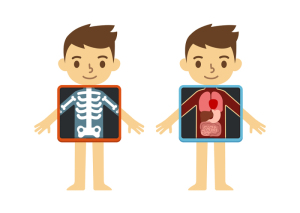by
John W. Mitchell, Senior Correspondent | October 31, 2016
Errors in pediatric X-ray interpretation mean more images, additional costs, unnecessary radiation exposure and a psychological impact on patients and their families — and they happen far more often than they should.
"As a result of our internal peer review program, we occasionally discover certain themes or subjects that are found to be recurrent diagnostic challenges," Dr. A. Luana Stanescu, assistant professor of radiology at Seattle Children's Hospital (SCH) told HCB News. "We felt that reviewing and publishing representative examples would help other radiologists to learn from our experience."
Stanescu was part of a research team that included colleague Dr. Randolph Otto, associate professor of radiology at SCH, which published in the current issue of the
American Journal of Roentgenology. The article consisted of several chest view case studies highlighting common pediatric imaging "pitfalls." In the article, the radiologists identified specific teaching points to assist other radiologists in recognizing important diagnostic clues and points in clinical context.




Ad Statistics
Times Displayed: 43426
Times Visited: 1280 Keep biomedical devices ready to go, so care teams can be ready to care for patients. GE HealthCare’s ReadySee™ helps overcome frustrations due to lack of network and device visibility, manual troubleshooting, and downtime.
"Interpretation of pediatric imaging examinations differs from those of adults," said Otto. "More in-depth understanding of normal developmental anatomy and pediatric disease processes is extremely helpful in the detection of subtle abnormalities and in avoiding common errors of interpretation."
The study presented eight case reviews of children ranging from ages 21-days to eight years old. Each case was discussed in depth. Children, especially babies and toddlers, are often difficult to image because they will not, or cannot, cooperate with positioning.
"Hopefully these (case studies) will serve as a reminder of the more general theme that children are not just small adults, and highlight the requisite knowledge of normal anatomy, growth, disease processes, and current clinical management needed for successful pediatric imaging," said Stanescu.
Reducing repeat and unnecessary imaging exams, especially among children, has become a priority in recent years under As Low As Reasonably Achievable (ALARA) standards. Groups such as Imaging Gently, a coalition of health care organizations, works to raise awareness about the need to adjust radiation doses with children.
The study emphasized that follow-up radiographic procedures, additional projections and further cross-sectional imaging are not always recommended or appropriate, especially in this age of ALARA. The use of a systematic approach to image interpretation, with an awareness of common errors and the underlying root causes, can aid both the pediatric and general radiologist in rendering accurate interpretations, the authors concluded.
Back to HCB News

